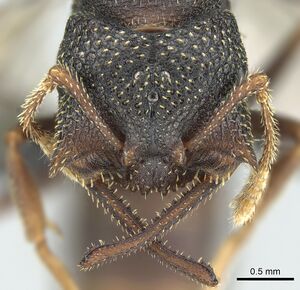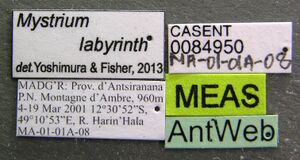Mystrium labyrinth
| Mystrium labyrinth | |
|---|---|

| |
| Scientific classification | |
| Kingdom: | Animalia |
| Phylum: | Arthropoda |
| Class: | Insecta |
| Order: | Hymenoptera |
| Family: | Formicidae |
| Subfamily: | Amblyoponinae |
| Tribe: | Amblyoponini |
| Genus: | Mystrium |
| Species group: | camillae |
| Species: | M. labyrinth |
| Binomial name | |
| Mystrium labyrinth Yoshimura & Fisher, 2014 | |
This species has been collected from rainforest litter samples.
Identification
Yoshimura and Fisher (2014) - Mystrium labyrinth females can be distinguished easily from the other Mystrium females in the Malagasy region by a combination of the following characters: the pronotal dorsum covered with strong regular reticulation; the second maxillary palpomere shorter than the third; the long genal tooth of head nearly reaching anterior end of the lateral lobe of the clypeus; and the first flagellomere (third antennal segment) as long as the pedicel (second antennal segment). The worker of M. labyrinth is similar to that of Mystrium silvestrii; however, M. labyrinth can be distinguished from M. silvestrii by an anterior clypeal margin with long, well-developed conical setae (weak in M. silvestrii and Mystrium mz01), and a moderately long petiole (short and wide in M. silvestrii as in Mystrium barrybressleri).
Keys including this Species
Distribution
Latitudinal Distribution Pattern
Latitudinal Range: -12.51444° to -15.58506°.
| North Temperate |
North Subtropical |
Tropical | South Subtropical |
South Temperate |
- Source: AntMaps
Distribution based on Regional Taxon Lists
Malagasy Region: Madagascar (type locality).
Distribution based on AntMaps
Distribution based on AntWeb specimens
Check data from AntWeb
Countries Occupied
| Number of countries occupied by this species based on AntWiki Regional Taxon Lists. In general, fewer countries occupied indicates a narrower range, while more countries indicates a more widespread species. |

|
Estimated Abundance
| Relative abundance based on number of AntMaps records per species (this species within the purple bar). Fewer records (to the left) indicates a less abundant/encountered species while more records (to the right) indicates more abundant/encountered species. |

|
Biology
|
Castes
Worker
Images from AntWeb
   
| |
| Holotype of Mystrium labyrinth. Worker. Specimen code casent0003281. Photographer Estella Ortega, uploaded by California Academy of Sciences. | Owned by CAS, San Francisco, CA, USA. |
Queen
Images from AntWeb
    
| |
| Queen (alate/dealate). Specimen code casent0084950. Photographer Estella Ortega, uploaded by California Academy of Sciences. | Owned by CAS, San Francisco, CA, USA. |
Nomenclature
The following information is derived from Barry Bolton's Online Catalogue of the Ants of the World.
- labyrinth. Mystrium labyrinth Yoshimura & Fisher, 2014: 47, figs. 10B,D, 14B, 33E, 34E, 35C, 36B,D,F, 42B (w.q.) MADAGASCAR.
- Type-material: holotype worker.
- Type-locality: Madagascar: Toliara, 5 km. N Isaka-Invondro (-24.75°, 46.8°), 350 m., 12.xi.1992, BLF00976, CASENT0003281 (B.L. Fisher).
- Type-depository: CASC.
- Distribution: Madagascar.
Unless otherwise noted the text for the remainder of this section is reported from the publication that includes the original description.
Description
Worker
Measurements: holotype. HL 1.73, HW 1.76, SL 1.08, ML 1.77, HD 1.03, WL 1.96, PnW 1.01, PpW 0.84, PtW 0.90, PtL 0.51, CI 101.7, SI 61.2, MI 100.5, PpI 83.0, PtI 176.1.
HL 1.67–1.79, HW 1.72–1.84, SL 1.05–1.09, ML 1.70–1.76, HD 1.03–1.09, WL 1.90–2.02, PnW 1.02–1.08, PpW 0.81–0.87, PtW 0.82–0.95, PtL 0.45–0.52, CI 102.0–102.8, SI 58.0–61.1, MI 92.2–99.4, PpI 79.0–82.7, PtI 180.4–183.8 (3 specimens measured).
Posterolateral corner of head moderately expanding posteriorly. Posterior face of vertex forming almost right angle with its dorsal face on median line of head, so that declivity of vertex on lateral part as steep as that on median part. Ventral half of vertex sculptured. Eye relatively larger than that of Mystrium barrybressleri. Anterior margin of clypeus convex with long conical setae, of which median pair larger than adjacent pair. Genal tooth of head relatively long, as long as lateral lobe of clypeus. Masticatory margin of mandible in full-face view slightly visible on its basal half, invisible on its distal half. Width of dorsal surface of mandible almost identical from mandibular shaft to distal portion. Second maxillary palpomere shorter than third. First flagellomere (third antennal segment) as long as pedicel (second antennal segment). Central part of pronotal dorsum and lateral surface of pronotum strongly and regularly reticulate. Mesonotum often not differentiated and indistinct from propodeum in dorsal view, its length as long as that of propodeum. Metanotal groove indistinct in lateral view, but mesonotum slightly higher than pronotum. Short, but distinct ridge present on dorsal edge of metapleural gland bulla. Petiole wide in dorsal view, but narrower than that of Mystrium barrybressleri (PtI<185).
Body color reddish brown to black.
Queen. Description.
Queen
Measurements: HL 1.65, HW 1.69, SL 0.99, ML 1.48, HD 1.10, WL 2.33, MnW 1.27, PtW 1.08, PtL 0.51, CI 102.5, SI 58.5, MI 87.6, MnI 74.8, PtI 212.2 (one specimen measured).
Wings present, well developed. Wing sclerites fully developed even if wings have dropped off. Posterolateral corner of head moderately expanding posteriorly; expansion weaker than that of workers. Posterior face of vertex forming almost right angle with its dorsal face on median line of head, so that declivity of vertex on lateral part as steep as that on median part. Ventral half of vertex sculptured. Eye well developed. Both anterior and lateral ocelli clearly present, median portion of lateral ocelli and posterior portion of anterior ocellus edged by blackish pigment. Anterior margin of clypeus convex, with long conical setae, of which median pair larger than adjacent pair. Genal tooth of head distinctly developed, reaching slightly posterior of lateral lobe of clypeus. Masticatory margin of mandible almost invisible in full-face view, and dorsal surface on distal portion as wide as that on mandibular shaft. Spatulate seta present on basal side of each basal denticle on masticatory margin of mandible. First flagellar segment on antenna as long as pedicel. Setae on pronotum distinctly spatulate, widened distally. Propodeal declivity in lateral view slightly convex on dorsal part of metanotal gland bulla, making blunt angle with its dorsal margin. Petiole relatively long in dorsal view, 0.5 × length of abdominal segment III.
Body color blackish brown.
Type Material
Holotype. Worker: CASENT0003281, BLF00976, MADAGASCAR, Toliara, 5 km N Isaka-Invondro (-24.75°, 46.8°), 350 m alt., 12.xi.1992, B.L.Fisher leg. California Academy of Sciences.
Etymology
This species name is the English word labyrinth, inspired by the strong reticulation covering the body surface of the new species. The species epithet is a noun, and thus invariant.
References
References based on Global Ant Biodiversity Informatics
- Yoshimura M., and B. L. Fisher. 2014. A revision of the ant genus Mystrium in the Malagasy region with description of six new species and remarks on Amblyopone and Stigmatomma (Hymenoptera, Formicidae, Amblyoponinae). ZooKeys 394: 1-99.

